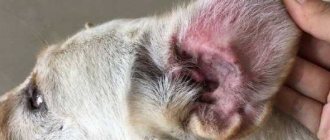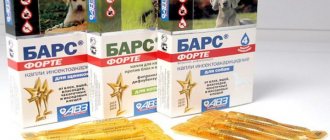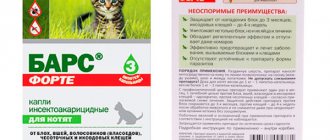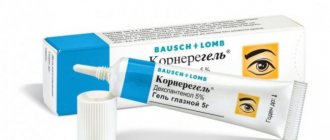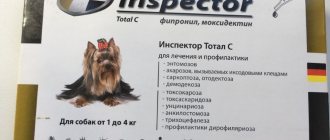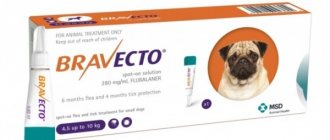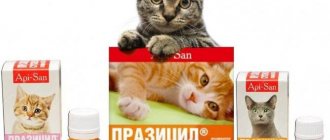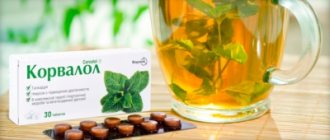Ear medications for dogs
Dog owners and breeders must not only provide their pet with optimal conditions of keeping and care, but also accustom the animal to the necessary hygiene procedures from the first days. To keep your beloved dog’s ears healthy, two or three times a month it is necessary to clean your pet’s ears from wax, dirt, secretions, crusts, using special antiseptic lotions, sprays, emulsions, drops and other veterinary preparations intended for hygienic treatment of the ear canal.
If, when examining the ears, there is noticeable redness, the presence of a large amount of wax, a dark, gray-brown coating, a specific unpleasant odor emanates from the ears, the pet shows anxiety, shakes its head, scratches the sore ear, caring owners should immediately take appropriate measures. For the treatment and prevention of ear diseases in dogs, there is a large selection of special veterinary preparations of domestic and foreign production. Moreover, before purchasing an otological drug, it is necessary to take the animal to a veterinary clinic to make an accurate diagnosis.
recommended articles:
- What to do if your dog has ear pain?
- Ear Diseases in Dogs: An Overview of Causes and Symptoms
How to put drops in a dog's ear
Ear drops for animals can be roughly classified into:
- Preventive. Used exclusively for preventive purposes, for cleaning and hygienic treatment of ears.
- Medicinal (antiparasitic, anti-inflammatory, antibacterial, antifungal). Used for the treatment of otitis of various etiologies, otodectosis. ear mites, fungal infections.
Most otological veterinary drugs, which today can be easily purchased in veterinary pharmacies and veterinary clinics in your city, have a complex (wide) spectrum of action. Suitable for the treatment of infectious-inflammatory, bacterial diseases of the ear, fungal infections, ear hematomas in our little brothers.
Depending on the biochemical composition, ear drops for dogs have a pronounced anti-inflammatory, antimicrobial, acaricidal, deodorizing, anesthetic, and disinfectant effect. With proper, systematic use, they eliminate itching in the ear canal, relieve inflammation, suppress the growth and development of pathogenic microflora, and activate regeneration processes in tissues. Ear drops may contain steroids, hormones, non-steroidal compounds, extracts of medicinal plants, essential oils, antibiotics, antiparasitic components, and alcohol.
Among the most effective otological veterinary medications for the prevention and treatment of ear diseases in dogs are:
- Bars, Bars Forte.
- Amitrazine Plus. Amitrazine Forte.
- Tsipam.
- Otoferonol Gold, Otoferonol Premium.
- Surolan.
- Oricin.
- Aurikan.
- Amit Forte.
- Demos.
- Decta.
- Anandin plus.
- Otovedin.
- Otibiovin.
- Pozateks.
- Otopedin.
- Tresaderm.
Do not forget that ear diseases have different origins and only after diagnosis will the veterinarian be able to prescribe an effective pharmacological drug for external treatment. If necessary, ear drops for dogs can be used with other pharmacological preparations - ointments, creams, emulsions. The frequency of use, dosage, and long-term treatment course are prescribed by the attending veterinarian.
General information about otitis media
A dog's ear consists of several parts:
- The external auricle , which serves as a locator and protection for the middle ear, where the main auditory organs (tympanic membrane, auditory tube, malleus and incus) are located. It is this link that is better developed in animals than in humans.
- The inner ear serves as a connection to the brain and conducts signals along nerve endings.
Otitis can appear in each of these sections, causing unpleasant symptoms. In addition, they can be caused by an infection, or cause an ear canal infection.
Causes of the disease
The causes may be related to both the environment and internal problems of the dog. Main prerequisites for the development of the disease:
- Drafts, strong winds and damp weather lead to hypothermia, colds and blowing ears, as a result - otitis media;
- Weak immunity (due to the inability to fight bacteria, the dog often gets sick and suffers relapses);
- Improper bathing, lack of drying (if water is regularly poured into the ears, and the animal is not dried and walks around wet, it is possible that otitis media will subsequently develop);
- Injuries, concussions, severe bruises;
- Allergies;
- Parasites (usually external: ticks, fleas, which destroy the integrity of the skin and membranes of blood vessels, spread poison and infection, cause irritation and itching);
- Reproduction of bacteria and viruses as a consequence of infectious infection (otitis may be a sign of proliferation of pyogenic cocci);
- Incorrect or irregular hygiene procedures;
- Getting foreign objects into the ear canals (from small children's toys to street dust and debris);
- Genetic predisposition of certain breeds;
- Hormonal imbalances (autoimmune or thyroid diseases);
- The presence of sugar in the diet (causes increased secretion of sulfur).
Varieties
Otitis is a complex disease that has various forms. First of all, there are two main types: primary and secondary. The first is considered independent, is very rare, and develops with frequent diving or walking in a draft. Secondary is caused by external negative factors - bacteria, insects and other irritants.
By anatomical location
The classification divides otitis media according to the location of the main inflammation. There is an external, middle and internal process. The first develops in the auricle and does not spread to the eardrum. Medium affects the main auditory organs and is considered the most common. Internal is the most dangerous; it can lead to infection of nerve endings and complications in the brain.
According to the irritant leading to the disease
There are subtypes that characterize otitis due to development. There are fungal, allergic, parasitic, bacterial and verrucous.
- Fungal otitis media appears due to pathogenic fungi and is called otomycosis. A characteristic feature is a clear manifestation of infection, covering the auricle and canals with a pimply crust. The fungus quickly mixes with wax and penetrates all parts of the ear. Without proper timely treatment, it can lead to serious and dangerous consequences.
- Bacterial is caused by the proliferation of bacteria for various reasons: weakened immunity, hypothermia, a disease that has not been treated. May cause hyperthermia and other symptoms of bacterial infection.
- Allergies cannot be treated using standard methods. First of all, the veterinarian determines the cause of the allergy. Anti-allergenic drugs are used. The disease causes severe itching, bumps, and irritation inside the ear.
- The verrucous type is caused by the proliferation of a wart inside the ear opening. Thus, growths and bumps block the ear canal.
- Parasitic otitis, as the name implies, is caused by external parasites: fleas, ticks, whipworms. Insects destroy the entire skin, inject poison, promote the growth of bacteria, and irritate the skin.
By the nature of the discharge
There are types of otitis media based on the substances they secrete. The most common is purulent . A characteristic feature is purulent, foul-smelling discharge from the middle or inner ear. The second type is exudative . In this case, the volume of sulfur in which bacteria multiply increases.
According to the nature of the disease
The intensity of symptoms and the speed of development divides otitis media into chronic and acute . In the first case, all signs are blurry, dim, and the flow is slow; this type is difficult to identify and difficult to treat, and is often associated with allergies. Acute otitis is manifested by sharp unpleasant symptoms: high fever, itching, pain, large volume of discharge. It is easier to detect, and therefore easier to cure.
Other types of otitis
In addition to the above types, traumatic otitis and seasonal otitis .
- The first type can be caused by a severe injury, falling from a high object, or foreign objects entering the ear canals.
- Seasonal otitis is associated with weather changes. Directly correlated with colds due to drafts and dampness. One of the main preventive measures is protecting your pet from the cold.
Main symptoms
Symptoms of otitis media are similar for all types, regardless of the cause. Of course, there are characteristic differences, but, one way or another, the main features are the same:
- Inflammation, redness of the auricle or ear canal;
- Uncharacteristic growths, bumps, scabs and crusts inside the ear;
- Unpleasant odor, increased volume of mucus and sulfur secreted;
- Increased body temperature;
- The pet is restless: it scratches, presses its ear, whines;
- Lack of appetite with severe thirst;
- You may notice that the animal tilts its head towards the sore ear or shakes it;
- Hearing impairment, the dog does not respond to names or commands;
- There may be severe strabismus (with deep damage);
- Any touch will be painful for the pet.
Leopard
In traditional veterinary medicine, “Bars” ear drops are prescribed not only to dogs, but also to cats of various age groups for the treatment of otodectosis, otitis of various natures, including bacterial and mycotic. The otological veterinary drug has a complex spectrum of action. The active components have a pronounced anti-inflammatory, antibacterial, antiseptic, fungicidal, acaricidal effect. "Bars" accelerates the healing of wounds, scratches, ulcers, relieves itching and severe pain.
Ear drops for dogs "Bars"
The composition of Bars ear drops includes: extracts of medicinal plants, diazinon, and other excipients. Packaged in polyethylene bottles of 20 ml. The veterinary drug is a light brown transparent liquid.
Side effects and allergic reactions after using drops are noted in dogs only in cases of individual intolerance to the active substances included in the pharmacological product, as well as in cases of non-compliance with the recommended dosage. No contraindications have been established.
Before putting drops in your dog’s ears, the ear canal must be carefully cleaned with a gauze and cotton swab soaked in peroxide to remove wax, scabs, plaque, and crusts. To achieve the desired effect, drops are instilled into each ear, three to five drops twice a day for 5-7 days. If necessary, treatment therapy can be repeated after three to four weeks.
Bars ear drops for dogs can also be used for preventive purposes, for hygienic cleaning of the ear canal and ears. To prevent ear diseases in dogs, it is used twice a month.
Dekta
Dekta ear drops are a complex acaricidal veterinary drug for external use. Prescribed to dogs for the treatment of otodectosis (ear scabies), notoedrosis, otitis, complicated by fungal and bacterial infections. Used exclusively for medicinal purposes!
The veterinary drug has a contact, systemic effect. Effective against ear mites. It has a pronounced anti-inflammatory, acaricidal, antibacterial (antimicrobial), anesthetic effect. When used systematically, Dekta accelerates epithelialization processes, promotes the activation of regeneration processes, quickly relieves pain, itching, and eliminates the unpleasant odor emanating from the dog’s ears.
The otological drug contains propolis, dexamethasone, amitraz, chloramphenicol, and other auxiliary components. Do not use for the treatment of ear diseases in pregnant, lactating bitches, weakened, exhausted, convalescent animals, puppies under 4 weeks of age, as well as dogs suffering from infectious diseases. If the recommended doses are strictly followed, no side effects are observed.
For medicinal purposes, treatment is carried out once a day for five to eight days with an interval of 7-10 days. Treatment is carried out until the clinical symptoms disappear completely. It is mandatory to instill Dekta ear drops into two ears, even if only one ear is affected by the mite. Before use, carry out hygienic cleaning of the ears. If necessary, after consulting with a veterinarian, the course of treatment with Decta can be repeated.
Ear drops for the treatment of ear diseases in dogs "Dekta"
Characteristic symptoms
Allergic otitis in dogs has its own characteristic symptoms that will help you quickly recognize the disease. The first sign will be a decrease in appetite and inactivity of the pet. Veterinarians identify a number of obvious symptoms of ear inflammation due to allergies:
- Pain in the outer ear area. The pain increases when touched, the dog begins to bark and run away.
- Visual enlargement of the ear in size, severe redness, and hair may fall out.
- Discharge from the ear is gray, yellow, brown. They can also be transparent.
- Unpleasant odor from the ear.
- Atypical behavior. Usually dogs begin to scratch their ears and bark in pain. They begin to characteristically shake their ears.
Read Causes of pug ear allergies: treatment methods and diet
The situation can become dangerous if bloody discharge appears from the ears. In the acute form of the disease, the body temperature may rise significantly. In severe condition, the disease can cause enlarged lymph nodes. In this case, the dog may partially or completely lose hearing, and sudden manifestations of aggression are typical.
The allergen can irritate not only the ears, but also other organs. Therefore, symptoms that are not characteristic of otitis media, but characteristic of allergies, may also occur. Watery eyes, runny nose, cough, diarrhea and constipation.
How to distinguish from other forms of otitis
In addition to allergic, there is also purulent and fungal otitis, but they are not so common. To distinguish these types from each other, several characteristic symptoms can be identified:
- Purulent otitis media manifests itself in a small seal in the ear and a sharp sour odor.
- Fungal otitis is characterized by increased secretion of sulfur and the formation of a large number of crusts in the auricle.
Otibiovin
Otibiovin is a complex drug for external use, which is prescribed to dogs for the treatment of acute, yeast, fungal ear infections, eczema of the ears, ear canal, and superficial dermatitis. The veterinary drug contains salicylic acid and an aminoglycoside antibiotic, which has a detrimental effect on most types of gram-negative and gram-positive bacteria.
Otibiovin has a broad antibacterial, bactericidal, deodorizing, anti-inflammatory, and antiseptic effect. Eliminates pain, relieves itching. Before using the drug for medicinal purposes, it is imperative to consult a veterinarian!
Otibiovine is instilled three to five drops into each dog's ear three to four times a day. Before the treatment procedure, the ear canal is cleaned of wax, scabs, and crusts. After instillation, massage the base of the auricle for a few seconds. The duration of the treatment course is 5-10 days, until the clinical symptoms are completely relieved.
There are no side effects when used correctly and the specified dosage is observed. Contraindications: ruptured eardrum.
Otibiovin – ear drops for dogs
Surolan
Surolan - ear drops for dogs. In veterinary practice, it is prescribed for the treatment of bacterial, fungal, parasitic otitis media, and dermatitis. The drug is a syrupy, transparent suspension with a slight specific odor. It contains miconazole nitrate, prednisolone acetate, and polymyxin B sulfate.
Surolan ear drops for dogs have excellent anti-inflammatory, anesthetic, antihistamine, and antiparasitic complex effects. Active components prevent the activity of gram-negative and gram-positive bacteria and pathogenic fungi.
When treating bacterial and fungal otitis, dogs are instilled with three to four drops into each ear twice a day, after cleaning the ear canal from dirt, wax, and plaque. Treatment is continued until clinical symptoms disappear completely. For chronic forms of ear diseases, the duration of treatment can be up to two to three weeks.
Surolan - ear drops for dogs for the treatment of bacterial, fungal, inflammatory otitis media
If you use Surolan according to the instructions, side effects occur only if the body is hypersensitive to the active components of the veterinary drug.
Otodepin
Veterinarians prescribe the hygienic ear drug “Otodepin” to animals for the effective treatment of external and internal otitis of various etiologies, as well as in the treatment of ulcers and hematomas. It is a light yellow transparent liquid of oily consistency with a pleasant pine odor. Packaged in sterile bottles of 10 ml. Otological veterinary medicine is also used for prophylactic purposes, to prevent the development of fungal and infectious diseases of the ears. Before use, the drops must be warmed to room temperature.
Otodepine contains pine essential oil, saponins, and mullein extract. The drug has a wound-healing, antimicrobial, antiseptic, deodorizing, and tonic effect. Eliminates inflammatory processes, improves metabolism in cellular structures, accelerates the healing of wounds and ulcers, and improves tissue trophism.
Otodepin for dogs
Otodepine does not have a sensitizing or toxic effect. Does not cause allergies. The drug is absolutely safe, low-toxic for dogs, regardless of their breed or age. It is acceptable to use for treatment and for preventive purposes in small puppies from three weeks of age. Side effects are noted in extremely rare cases and only in case of individual intolerance to the active components. Before use, carefully read the instructions for the veterinary drug.
Amitrazine Forte
Amitrazine Forte is an effective complex drug for the treatment of demodicosis, notoedrosis, sarcoptic mange, otodectosis, bacterial and fungal otitis, and mycoses in dogs. It has a low degree of toxicity and high penetrating ability. Belongs to the category of low-toxic veterinary drugs.
Amitrazine Forte has antifungal, acaricidal, analgesic, anti-inflammatory, antiseptic, and deodorizing effects. Active substances inhibit secondary pathogenic microflora in lesions, accelerate regeneration processes, relieve pain and itching.
Amitrazine is instilled into each ear in a dosage of 0.2-1 ml depending on the size, body weight, and breed of the dog once a day with an interval of three days, but until the clinical symptoms completely disappear. When treating mycoses - once a day for three to five days. If necessary, treatment is repeated after 7-10 days.
Consolidated list of medications recommended for treatment
| Group of drugs | Drug name | Mode of application |
| Ear hygienic cleaning products |
| The whole bottle (5 ml) is poured into the ear of large breeds, half of small ones; Gently massage the ear with a cotton swab |
| A cotton swab is soaked generously, the auricle is wiped with massaging movements | |
| Means for antiseptic cleaning and treatment of ears |
| A cotton swab is generously soaked in the drug and the pet’s ears are washed; you can pour a small amount into the ear, and then collect the leaking liquid |
| Pour into the ear canal, rinse with cotton swabs | |
| Soak a cotton swab and then wipe the ear canals | |
| Wound healing and antiseptic ointments |
| The product is applied to ear wounds (pre-treated) 1 time per day until healing |
| Apply once a day, the ointment is applied in a thin layer to the wounds of the auricle | |
| Used like Levmikol, 2 times a day | |
| Ear drops with analgesic, anti-inflammatory and antipruritic effects |
| 2-3 drops into the ear canal 3-4 times a day, treatment duration – 10 days |
| ||
| Ear drops with a pronounced antimicrobial effect |
| 3 times a day, 5 drops in each ear, duration is determined by the severity of the disease |
| 7 days 1 time per day, 3-5 drops in each ear | |
| Maximum duration – 12 days; 4 drops in the ear, massaging; the first days of treatment – 4 times, then – 2-3 times a day | |
| After cleansing, 3-4 drops are instilled into the ears, 3 times a day. | |
| Ear drops against fungal otitis |
| 6 times a day for 20 days, 3-4 drops in the sore ear |
| ||
| ||
| Antiparasitic ear drops (against ticks) |
| 5 days 3-5 drops in each ear |
| One-time instillation, repeat after 10 days; The volume of 1 pipette is divided into two ears | |
| 2 times a day for 5 days, 2-3 drops, massaging the ears | |
| 5-7 days, repeat after 1 week; 3-4 times a day, 1-2 ml of solution (dose prescribed by a veterinarian) | |
| Immunostimulants |
| 0.1 ml per 1 kg, injection is given intramuscularly (in the thigh) once every 2 days |
| 1 ml per day is injected into the thigh or subcutaneously | |
| Antibiotics for otitis media |
| 5-7 daily injections of 2-3 ml |
| 1-2 injections per day, 2.5 ml |
Tsipam
Tsipam – acaricidal-insecticidal ear drops for dogs with contact-intestinal action. The drug is a light, oily, homogeneous liquid. Packaged in polyethylene sterile dropper bottles, packed in cardboard boxes. "Tsipam" is prescribed for the treatment of otodectosis, notoedrosis, sarcoptic mange, psoroptosis, demodicosis, otitis, complicated by bacterial infections.
The active components of Tsipam help destroy ixodid and sarcoptoid mites, which provoke the development of ear scabies in dogs, cats, and other warm-blooded animals. The veterinary drug is effective against adult parasites and their larvae. “Tsipam” for dogs is also effective against fleas, ticks, and lice.
Tsipam ear drops are not recommended for use simultaneously with other pharmacological agents for external treatment. Before use, we recommend consulting with a veterinarian who will select the optimal course of treatment. There are no contraindications to the use of the veterinary drug.
Tsipam for the treatment of ear diseases of various etiologies in dogs
Otoferanol Premium
Otoferanol Premium is prescribed to dogs for the treatment of ear scabies. The veterinary drug has a pronounced acaricidal contact-intestinal effect. kills parasites at all stages of their development. The active substances of Otoferanol have anti-inflammatory, antiseptic, and antimicrobial effects.
For medicinal purposes, after first clearing the ear canal of contaminants, three to five drops of the drug are instilled into each ear using a pipette. Decorative, small dogs - 3 drops each, medium dogs - 4 drops, large dogs - five drops. Treatment is carried out twice with an interval of four to seven days.
Ear drops for dogs “Otoferanol Premium”
Otoferanol Gold
The veterinary preparation is intended for external use. Prescribed for dogs with otodectosis, sarcoptic mange, otitis, complicated by bacterial flora. Otoferanol Gold has a detrimental effect on ixodid and sarcoptic ticks at all stages of their development. Available in 10 ml bottles.
Ear drops are low-toxic, safe veterinary drugs of the new generation. The active components included in the drug have anti-inflammatory, regenerating, antimicrobial, fungicidal effects, accelerate the healing of wounds, ulcers, microcracks, and promote the restoration of cellular structures in damaged tissues. Five drops are injected into each ear of large dogs and three drops of decorative and small breeds with an interval of seven days.
Aurikan
Ear drops "Aurican" is an effective complex veterinary drug for external use, which has anti-inflammatory, deodorizing, antiseptic, bactericidal, bactericidal, insecticidal, and anesthetic effects. In veterinary practice it is used in the treatment of ear scabies in dogs.
The main active components included in Aurican: sodium prednisolone metasulfobenzoate, hexamidine isothionate, tetracaine hydrochloride, lindane, and other excipients.
Depending on the dimensions. breed of dog in the treatment of otodecosis, bacterial, fungal otitis, 5-15 drops are instilled inside the ear canal. Use once a day for a week until the clinical symptoms are completely relieved. For preventive purposes after curing a pet - once a day, two to three times a week for 28-30 days.
Aurikan – otological drops for dogs, puppies
"Aurican" is strictly unacceptable for use on animals in case of rupture (perforation) of the eardrum, as well as in the event of allergic reactions in the case of individual hypersensitivity to the components of the pharmacological drug.
Treatment at home
Treatment at home can only be primary: helping the animal with severe painful symptoms. Subsequent manipulations should be carried out under the supervision of a doctor, namely:
- Complete relief of pain and irritating symptoms;
- Diagnosis of the type of disease;
- Elimination of discharge and growths;
- Treatment of the main source of inflammation and subsequent complications;
- Removing decay products and toxic elements from the body;
- Restoring the immune system.
If the passage is densely overgrown, surgical intervention will be required.
What not to do if you are sick
- It is strictly forbidden to treat a pet without the intervention of a doctor. Antibacterial drugs can cause microbes to become resistant to drugs, which will complicate subsequent treatment.
- You should not clean your animal's ears with cotton swabs. They can damage fabrics and will not remove all contaminants. In veterinary medicine, tweezers or a clamp with a cotton swab are used. Ear cleaning should only be done if you have experience. Otherwise you may scare the dog. This will make subsequent inspections difficult.
- It is not recommended to pour peroxide directly into the ear holes . Hissing and foam will cause fear in your pet. This medication is used only for treating external wounds.
Disease prevention
For prevention, it is important to take care of the hygiene of the ear cavity: cut or pluck out the inner hairs, monitor the entry of water into the passages, conduct a routine examination at least 2-3 times a week, pay attention to changes in the consistency, smell or color of the discharge.
It is necessary to reduce the animal's trips in the car with the windows open, and ensure that there are no drafts in the place where the pet sleeps. In cold windy weather it is necessary to wear protective suits (preferably with hoods). It is not allowed to feed your pet sweets.
Anandin, Anandin Plus
Ear drops for dogs “Anandin”, “Anandin Plus” are used in the treatment of acute and chronic otitis media and otodectosis in dogs. The acaricidal veterinary preparation contains synthetic pyrethroids and anandin, a substance that has a strong anti-inflammatory, antimicrobial, and bactericidal nature.
Anandin Plus effectively fights sarcoptic mites, suppresses the growth of pathogenic flora and other microorganisms that provoke inflammatory processes in the outer, middle, and inner ear. After the first use, ear drops relieve irritation, severe itching, pain, and discomfort. Helps in the treatment of fungal, infectious and inflammatory ear diseases in dogs and cats.
Anandin belongs to the group of moderately toxic drugs, so we recommend consulting with a veterinarian before use. Stick to the dosage indicated in the instructions. In recommended doses, when used correctly, the veterinary drug does not cause allergies, does not have a sensitizing or toxic effect.
Anandin for dogs
Treatment at home
If otitis media is detected in dogs, how to treat it at home? At first, you can alleviate your pet’s condition at home.
As home measures you can use:
- If there is severe scratching, the inner surface of the ear is wiped with hydrogen peroxide and carefully dried with a gauze bandage. Scratches are lubricated with brilliant green.
- If pus has accumulated and the ear “squishes,” you should carefully clean it with boric alcohol, blot it dry and cover it with streptocide powder.
- Dark plaque can be caused by mites. In this case, the auricle is freed from wax accumulations and lubricated with phenothiazine.
Manipulations should be carried out extremely carefully so as not to cause irritation in the affected areas.
Oritsin
"Oricin" - ear drops for dogs, a solution for external use, which, in addition to antibacterial and anti-inflammatory effects, has a strong anesthetic effect. Prescribed for the treatment of otitis media of various etiologies, including bacterial and fungal origin. The drug can also be used to treat otitis media complicated by otodectosis and fungal infections.
Oricin ear drops belong to the category of moderately toxic pharmacological drugs. If the recommended dosage is followed, there are no side effects. The veterinary drug does not have any responsive-toxic or allergic effects.
For dogs, 4-7 drops of Oritsin are instilled into the ear canal for four to seven days. Therapeutic therapy is carried out under the control of the treating veterinarian.
Oritsin
Diagnostics
If symptoms of otitis are detected, it is important to consult a doctor as soon as possible and have an examination at a veterinary clinic. Specialists can do this in several ways:
- Instrumental method or otoscopy (the method is superficial, but reveals large formations, growths, possibly objects);
- X-ray (a method based on X-rays allows you to determine the nature of formations and growths);
- A complete laboratory examination (blood, urine, smears and skin scrapings are analyzed; allows you to determine the type of pathogen, not only the type of otitis media, but also a specific type of fungus or insect; identifies allergies, including to antibiotics);
- Magnetic resonance or computer tomography (the latest methods that allow you to track the depth of penetration of the disease, possible inflammation of the brain or inner ear canal).
The examination allows you to identify the specific cause of the disease and prescribe the necessary treatment for a specific type of otitis. You cannot use self-medication; different types require specific therapy.
How to help a dog with signs of otitis media before contacting a veterinarian
- First of all, it is necessary to carefully examine the sore ear, without using tools or various objects. If there are wounds on the outer part of the auditory organ, you need to treat them with peroxide or brilliant green (brilliant green).
- To relieve painful symptoms or itching, you can instill harmless Otipax drops into your pet’s ears. In addition to the main analgesic functions, they soften the ear formations, which makes it possible to painlessly clean the canals or use tampons.
- If there is pus or copious liquid discharge inside the ear (can be determined by the characteristic squelching), you need to add streptocide and boric acid powder (1:5) . When contaminants come to the surface, they must be collected. During the period of action of the powder, you should not let your pet shake its head.
If fever is observed, a familiar antipyretic should be given. If there are no similar ones, you should not experiment.
Posatex
Pozateks are ear drops for dogs that are used as an antibacterial, antimicrobial, analgesic, antifungal external drug in the treatment of acute and chronic otitis of various etiologies and pathogenesis. Available in the form of a clear liquid. The main active ingredients are orbifloxacin, mometasone, posoconazole. The veterinary drug is packaged in polymer bottles with a pipette dispenser, which are packed in cardboard boxes.
Pozateks – a drug for the treatment of ear diseases in dogs
"Pozateks" is instilled into dogs once a day into the ear canal after first cleaning the ear of dirt, wax, crusts, and scabs. For representatives of large, large breeds, if the pet weighs more than 12-15 kg, when treating otitis media, five to eight drops of the drug are injected into each ear. For dogs weighing from 2 to 15 kg - three to four drops of Pozatex in each ear. The course of treatment is seven to nine days.
For hygienic treatments, veterinary specialists categorically do not recommend the use of medications that contain antibiotics, hormones, or steroid compounds. To carry out such manipulations and cleanse the ear canal, you can purchase in veterinary pharmacies: “Fitolar”, “Bars”, “Rosinka”, “Epi-otik”, and other preventive products for cleaning dogs’ ears.
We invite you to join our Zen channel and group on VKontakte or Odnoklassniki, where new articles for pet owners are published.
Similar articles:
- Reparin-Helper - a regenerative medicine for dogs
- How many days before vaccination should I give my dog anthelmintic?
- What are the best anti-tick drops for dogs?
Breeds particularly susceptible to otitis media
Breeds with a specific structure of the auricle or with long hair that grows in the ears are prone to the appearance and development of otitis.
Thick guard hairs obscure the canal, interfere with natural ventilation, and promote the accumulation of sulfur and the proliferation of bacteria in it. The risk group includes all pets with long hair: Lapdogs, Pekingese, Yorkshire terriers, Setters, long-haired Toy terriers, etc.
Similar problems arise in animals with long floppy ears: Spaniels, Setters, Bassets, Poodles. In addition, the self-cleaning mechanisms are hampered by the abundant skin folds around the ears of Bulldogs, various breeds of Mastiffs, and Shar-Peis.
A separate group predisposed to the disease are dogs with long erect ears: German Shepherds, Corgis, Staffies, Giant Schnauzers. They turn their ears to the wind, thereby catching drafts and chilling the hearing organs.
Any breed can be affected by the disease. It is important to monitor the hygiene of the ear cavities, checking it for dirt, strange discharge and stuck objects.
How dangerous is the disease?
In general, with timely and competent treatment, otitis media will not be a dangerous disease. However, in the opposite case, inflammation develops into chronic inflammation and attracts unpleasant problems. The first terrible complication is hearing loss (complete or partial).

